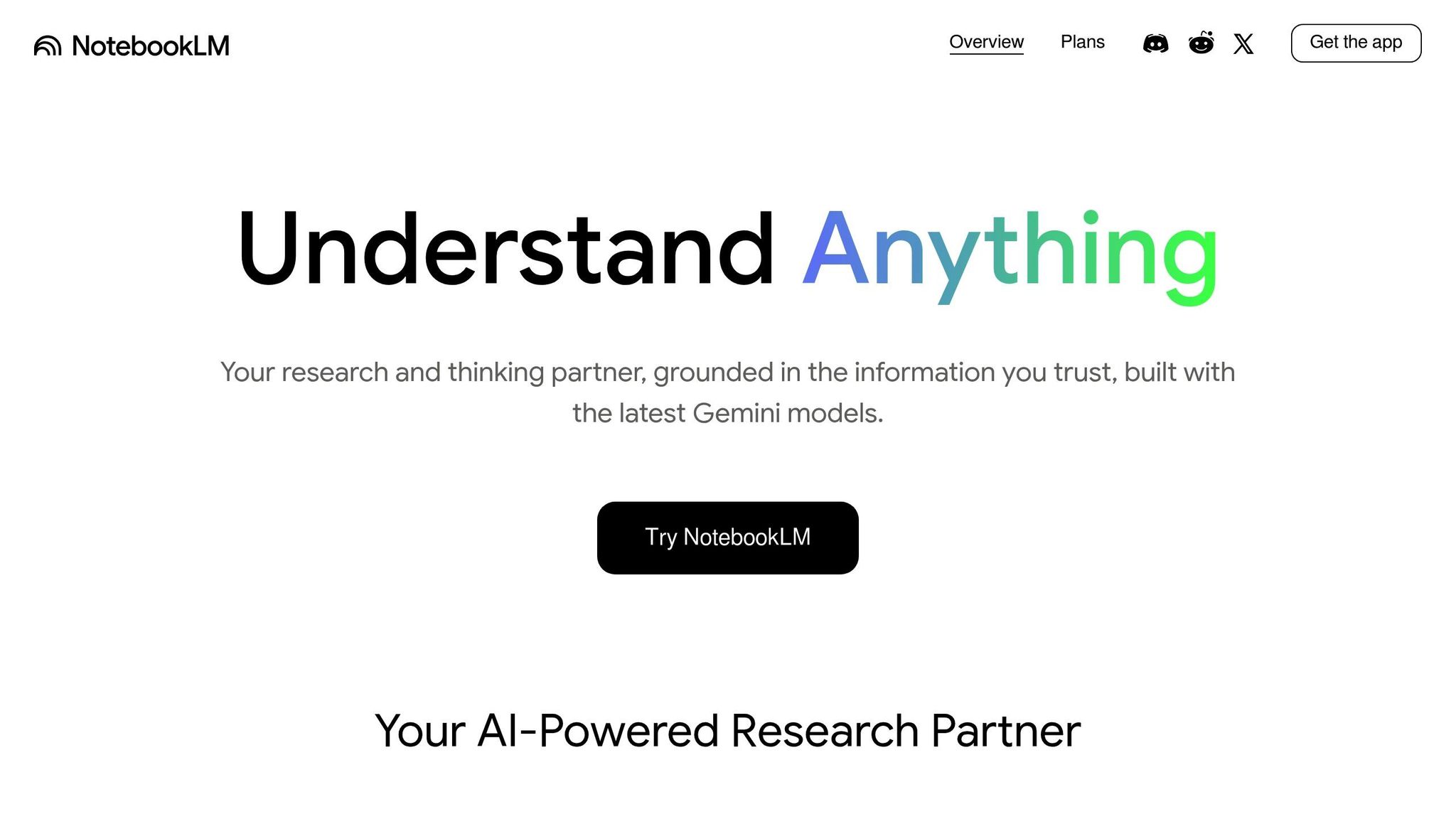AI is transforming how SaaS companies grow by pinpointing which product features drive revenue, retention, and engagement. AI-powered systems analyze user behavior, segment customers, and predict feature adoption, enabling data-driven decisions that replace guesswork. Here’s the key takeaway:
- AI identifies growth opportunities by analyzing usage patterns, customer support data, and billing history.
- It predicts feature adoption using machine learning, helping prioritize updates that boost metrics like annual recurring revenue (ARR).
- Real-time systems adapt suggestions as user behavior shifts, reducing churn and improving retention.
- Ethical AI practices matter, including privacy compliance and bias checks, to build user trust and maintain fairness.
AI The Best Way to Implement AI in SaaS Products - NotebookLM Podcast

AI Methods for Feature Recommendations
SaaS companies are increasingly tapping into AI to analyze user behavior and identify features that drive growth. From traditional machine learning techniques to cutting-edge real-time personalization, these methods are reshaping how companies understand and serve their users. Let’s dive into how user segmentation and clustering play a key role in these recommendations.
User Grouping and Clustering
Clustering algorithms are at the heart of many feature recommendation systems. They group users based on shared behavior patterns, uncovering segments that go beyond basic demographics. A widely used method, k-means clustering, organizes users by factors like how often they use certain features, how long their sessions last, and their overall engagement. These groups often align with subscription levels or specific industry needs.
For more detailed insights, hierarchical clustering creates nested groups, revealing subtle differences in user behavior. For example, a SaaS company might find that enterprise users in healthcare prioritize completely different features compared to small business users in the same field. This kind of segmentation helps companies prioritize features that resonate with specific groups, driving both engagement and revenue.
Advanced techniques like DBSCAN take it even further by identifying outliers - users who don’t fit into any standard group. These outliers can be highly valuable, often representing either power users who love the product or customers at risk of leaving. Both groups benefit from tailored feature recommendations.
Predicting Feature Adoption
Gradient boosting and neural networks are especially effective for predicting which features users will adopt. These models can process vast amounts of non-linear data, picking up on subtle patterns that simpler algorithms might overlook. By analyzing hundreds of variables - ranging from basic metrics like login frequency to more complex behavioral indicators - they provide deeper insights into user preferences.
Random forest algorithms strike a balance between accuracy and clarity. They not only deliver reliable predictions but also highlight the specific factors driving feature adoption. This makes them a valuable tool for SaaS companies deciding where to allocate resources or which features to prioritize.
For even stronger predictions, ensemble methods combine multiple algorithms into a single system. By leveraging the strengths of different approaches, these models produce more dependable forecasts across a variety of user groups and market scenarios.
Real-Time Personalization Systems
While predictive models focus on forecasting, real-time systems adapt recommendations as user behavior changes. Techniques like contextual bandits and reinforcement learning adjust recommendations on the fly, using immediate feedback to improve suggestions. Unlike traditional systems that rely heavily on historical data, these methods evolve with users’ shifting preferences.
Multi-armed bandit algorithms are particularly useful for large-scale A/B testing of feature recommendations. They dynamically allocate more traffic to successful options while still exploring new possibilities. This ensures SaaS companies get the most value from each user interaction while minimizing the risk of ineffective recommendations.
A standout example is Thompson sampling, a type of bandit algorithm that works well in fast-changing environments. It balances trying out new recommendations with focusing on proven ones, making it ideal for SaaS platforms where user preferences can shift quickly.
Data Requirements for AI Recommendations
For AI recommendations to hit the mark, they need precise data collected at the right moments. SaaS companies must focus on tracking key actions, defining metrics that measure success, and consistently improving the quality of their data. This high-quality data is what powers AI-driven recommendations to deliver actionable business insights.
Event Tracking and Data Collection
Accurate event tracking is the backbone of effective AI recommendations. Every user action - whether it’s a click, hover, scroll, or interaction - reveals insights into their preferences and behaviors. By mapping the entire user journey, companies can capture both obvious and subtle interactions, ensuring the data collected is ready for AI modeling.
To keep event tracking organized and useful, standardize event names using a consistent format like [action]_[object] (e.g., click_export_button). Include parameters such as page_name, feature_category, user_segment, and session_duration to add depth to the data. These enrichments give AI algorithms the context they need to provide more accurate and relevant recommendations.
However, data quality is critical. Inaccurate or incomplete event tracking can lead to flawed insights and underperforming models. Ensuring the data is clean and comprehensive should always be a top priority [1][2].
Creating Success Metrics
AI systems need clear and meaningful metrics to define success - basic usage stats just won’t cut it. Success metrics should connect user interactions with business outcomes, capturing both immediate behaviors and long-term trends like continued feature usage and overall engagement.
For example, understanding if users stick with a feature over time or if adopting a feature improves retention rates offers a clearer picture of its value. Tying feature performance to financial outcomes, such as revenue growth or reduced churn (expressed in U.S. dollars), can also highlight the return on investment for new features. This allows AI systems to prioritize recommendations that drive growth and long-term value.
Metrics should also reflect the differences between user segments and subscription tiers. For instance, a feature that’s highly beneficial to enterprise customers might not have the same impact on smaller accounts. Tailoring recommendations to meet the distinct needs of each segment ensures that all users benefit. These refined metrics feed directly into feedback systems, allowing recommendations to adjust in real time.
Building Feedback Systems
With solid data tracking and well-defined metrics in place, the next step is to establish feedback systems that keep AI recommendations accurate and relevant. Human-in-the-loop processes are particularly valuable here, as they provide oversight to catch edge cases, monitor model drift, and incorporate insights that data alone might miss.
Feedback loops should capture both explicit and implicit user responses. Explicit feedback might include ratings, feature adoption choices, or survey responses about recommendation quality. Implicit feedback, on the other hand, comes from user behaviors - like how much time they spend exploring a recommended feature, whether they complete suggested actions, or how their engagement patterns change afterward.
Tracking model drift is also essential. Over time, as user behaviors shift or new features roll out, AI models can lose their edge. Regularly comparing predicted outcomes with actual results helps identify when models need to be retrained.
Finally, frontline teams play a vital role in providing qualitative insights. They can spot trends or frustrations that aren’t immediately visible in the data. Setting up quick-response processes to adjust or pause recommendations when issues arise ensures the user experience remains smooth while problems are resolved. This combination of continuous monitoring and human input keeps AI recommendations relevant and effective.
sbb-itb-9cd970b
Measuring AI Impact on Business Results
When implementing AI-powered feature recommendations, it's crucial to measure their effects on revenue, user retention, and engagement. It's not enough to simply track clicks or adoption rates - what truly matters is connecting the AI model's performance to measurable business outcomes. Metrics like revenue growth and long-term engagement help bridge the gap between technical performance and how users actually behave.
Model Performance Metrics
Before rolling out AI models, evaluate their performance using key technical metrics. These include:
- Area Under the Curve (AUC): This measures the model's ability to differentiate between users who are likely to adopt a feature and those who aren't. A higher AUC generally means the model is better at making accurate predictions.
- Precision and Recall: Precision focuses on how accurate the recommendations are, while recall measures how many valuable features the model identifies. A smaller, highly relevant set of recommendations often works better than a lengthy, generic list.
- Log Loss: This metric gauges the model's confidence in its predictions by analyzing probability accuracy. Comparing log loss across versions helps identify improvements in both prediction quality and confidence.
While these metrics are essential for evaluating technical performance, they must align with business outcomes to ensure the recommendations truly meet user needs.
Live Testing and A/B Experiments
A/B testing is a cornerstone for evaluating how AI recommendations perform in real-world scenarios. This involves splitting users into two groups: a control group (receiving standard suggestions) and a treatment group (receiving AI-driven recommendations). Key metrics to track during live testing include:
- Feature Adoption Rates: Measure the percentage of users who start using the recommended features. This directly reflects the quality of the recommendations.
- Engagement Metrics: Monitor active user counts, such as daily active users (DAU) and monthly active users (MAU), to see if AI recommendations drive sustained engagement.
- Revenue Impact: Track metrics like average revenue per user (ARPU), free-to-paid conversions, and expansion revenue to gauge the financial benefits of AI recommendations.
- Retention Analysis: Compare retention rates over time to determine if users exposed to AI recommendations remain engaged longer than those who aren't.
To ensure meaningful results, run these tests over a period that captures a variety of user behaviors and usage patterns.
Long-Term User Behavior Analysis
Short-term tests are useful, but they often miss the bigger picture. Long-term analysis provides a deeper understanding of how AI recommendations impact users over time. Key areas to focus on include:
- Cohort Analysis: Track specific user groups over extended periods to see how their engagement evolves after being exposed to AI-driven recommendations.
- Feature Stickiness: Assess whether users continue to interact with the recommended features over time. High-quality recommendations often lead to ongoing usage, unlike more generic suggestions.
- Behavioral Pattern Changes: Look at metrics like session duration, feature exploration, and cross-feature usage to understand if AI recommendations are enhancing the overall user experience in a lasting way.
- Revenue Cohort Analysis: Evaluate long-term financial outcomes, such as renewals, upgrades, and customer lifetime value, by comparing users exposed to AI recommendations with those who aren't.
AI Ethics and Compliance for SaaS
Developing AI systems for feature recommendations requires a strong commitment to ethical standards and regulatory compliance. SaaS companies face the challenge of balancing user data utilization with privacy obligations, ensuring fairness across diverse user groups, and maintaining system reliability as their platforms grow and change. These efforts are crucial not just for meeting legal requirements but also for fostering user trust. Below, we dive into how privacy, bias prevention, and model stability work together to enable responsible AI practices.
Privacy and User Consent
AI recommendation systems rely heavily on user data, but with that reliance comes the responsibility to protect privacy. One of the first steps in safeguarding user data is data anonymization, which removes personal identifiers while retaining the behavioral insights needed for effective recommendations.
Equally important is obtaining explicit user consent, particularly as state-level privacy laws like the California Consumer Privacy Act (CCPA) and Virginia Consumer Data Protection Act (VCDPA) become more widespread. These laws require companies to clearly disclose how data is collected and used, while also giving users the right to opt out of certain practices. To meet these requirements, SaaS companies must design consent mechanisms that are easy to understand and avoid overwhelming users with technical jargon.
Some effective strategies include:
- Progressive disclosure, which provides key information upfront while offering more details upon request.
- Just-in-time notifications, which explain data usage in the context of specific user actions.
Another critical aspect of privacy compliance is data retention policies. While AI models need historical data to make accurate predictions, retaining user data indefinitely can create privacy risks and compliance challenges. Many companies address this by adopting tiered retention policies - keeping aggregated behavioral data for longer periods while purging individual user identifiers once they’re no longer required for model performance.
Bias Prevention and Transparency
Fairness in AI recommendations is just as important as privacy. Without proper oversight, AI systems can unintentionally reinforce biases present in the data they’re trained on, leading to unequal treatment of user groups. For instance, historical disparities in usage patterns can create feedback loops that disadvantage certain demographics over time.
To combat this, SaaS companies can implement regular bias audits, which involve analyzing recommendation trends across various user demographics, industries, and usage levels. For example, if enterprise users consistently receive recommendations for advanced features while small businesses are directed toward basic ones, this could signal bias rather than appropriate tailoring.
Algorithmic transparency is another key element. While companies don’t need to disclose proprietary algorithms, they should provide clear explanations of how recommendations are generated, the factors influencing them, and how users can shape their own experience. Internally, this transparency helps product teams identify and address potential issues. Externally, it builds user trust by making AI systems more understandable.
Using diverse training data is also essential. This means actively gathering input from underrepresented user groups, adjusting data collection methods to capture a wide range of behaviors, and ensuring the model doesn’t over-prioritize majority user patterns at the expense of minority groups.
Model Stability and Performance Monitoring
AI recommendation systems must remain reliable as SaaS platforms evolve with feature updates, interface changes, and shifting user behaviors. Major platform changes can render historical training data less relevant, potentially affecting model performance.
To address this, companies should continuously monitor both technical and business metrics. These include prediction accuracy, recommendation relevance, user satisfaction, feature adoption rates, and engagement levels. Sudden declines in any of these metrics could signal that the model is struggling to adapt to platform changes or new user needs.
Maintaining version control is another critical practice. By keeping detailed records of training data, algorithm parameters, and performance benchmarks for each model version, teams can quickly identify and address performance issues during updates. Comparing new model outputs against established baselines ensures recommendations remain effective.
Lastly, gradual deployment strategies can help maintain stability during model updates. Instead of rolling out new systems to all users at once, phased rollouts allow companies to test updates with smaller user groups, monitor performance, and address any issues before scaling up. This approach minimizes disruptions and ensures a smoother transition to improved models.
Conclusion: Using AI for SaaS Growth
AI-driven feature recommendations present a powerful opportunity for SaaS companies aiming to boost growth and increase annual recurring revenue (ARR). The strategies discussed - ranging from user clustering and predictive modeling to real-time personalization - lay the groundwork for delivering the right features at the right time.
While implementing AI requires a solid data foundation, it’s entirely within reach. Companies need effective event tracking systems to capture user activity across all touchpoints, clearly defined success metrics that align with their goals, and ongoing feedback loops to refine and enhance AI models over time.
Equally important is a commitment to ethical AI practices. With privacy regulations evolving across the U.S., it’s critical for SaaS companies to build systems that prioritize user trust. This includes anonymizing data, securing explicit user consent, conducting regular checks for bias, and ensuring transparency in how algorithms operate. These measures not only help avoid compliance issues but also strengthen user confidence.
The benefits of AI recommendations are clear: increased engagement, improved user retention, and higher revenue. By surfacing features that users might not discover on their own, SaaS teams in the U.S. can drive meaningful ARR growth.
Beyond immediate revenue, there’s a competitive edge to be gained. Companies leveraging AI effectively unlock valuable user insights, which can guide smarter product development and more targeted go-to-market strategies. For instance, businesses can pinpoint which features deliver the most value to specific user groups and refine their onboarding processes accordingly.
For teams considering this investment, the best approach is to start small and scale up. Begin with straightforward user segmentation and basic rules, then transition to more sophisticated models as your data and expertise expand. Viewing AI recommendations as a long-term strategy - not just a quick fix - will yield the best results.
As competition intensifies in the SaaS world, AI-powered feature recommendations stand out as a reliable path to sustained growth. The technology is ready, the methods are proven, and the potential impact on your business is immense. Now is the time to build the necessary data systems and governance frameworks to take full advantage of this opportunity.
FAQs
How does AI identify features that drive growth for SaaS companies?
AI plays a key role in helping SaaS companies pinpoint the features that drive growth by examining user behavior, preferences, and engagement patterns. By diving deep into data, it reveals trends and opportunities, allowing businesses to prioritize features that truly connect with their audience.
With tools like predictive analytics and customer segmentation, AI can predict which features - such as personalization, automation, or predictive insights - will have the greatest impact on user retention and satisfaction. This focused strategy ensures SaaS companies channel their resources into developments that directly contribute to their success.
What ethical factors should SaaS companies consider when using AI for feature recommendations?
When applying AI to recommend features, SaaS companies need to prioritize transparency, privacy, and fairness. Be upfront about how AI shapes user experiences, protect user data with robust access controls and anonymization, and routinely evaluate algorithms to reduce bias.
Using AI responsibly also means finding the right balance between innovation and ethical practices. Set clear policies, maintain accountability, and align AI usage with both user trust and regulatory standards. These efforts not only build user confidence but also help businesses thrive in a competitive SaaS landscape.
How can SaaS companies keep their AI models accurate and effective as user behavior and platform features change?
To keep their AI models accurate and relevant, SaaS companies need to prioritize ongoing monitoring and consistent updates. Techniques like real-time data collection, online learning, and incremental updates help AI systems quickly adjust to shifts in user behavior and platform changes.
On top of that, adopting robust AI governance practices is key. Regular performance reviews and periodic retraining ensure models stay in sync with current trends. By taking these proactive steps, companies can maintain AI solutions that effectively boost user engagement and drive growth.



